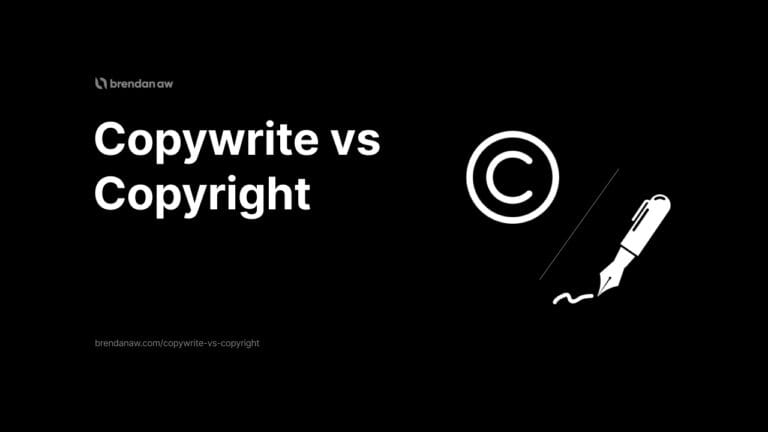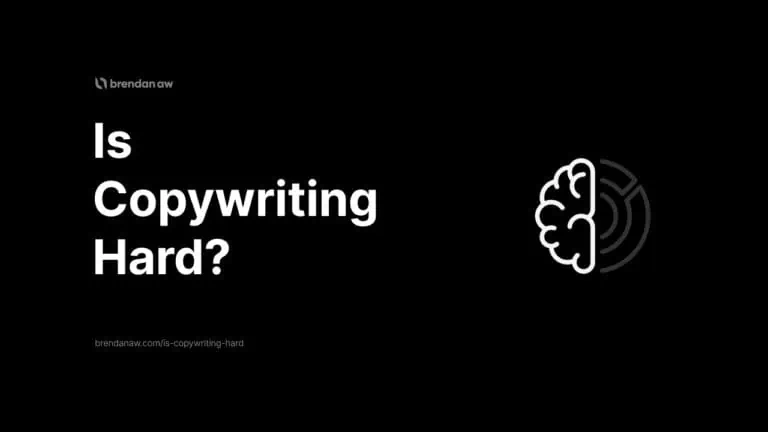The best content creators are great copywriters.
Like copywriters…
They influence followers’ decisions through written or spoken words.
Honing your persuasive copywriting skills is the key to winning as a content creator.
But how can you practice this skill?
Like any other skill…
The more you do it. The better you’ll get.
In this article, I’ll share some of my best copywriting exercises I used at the start of my journey.
All you need to do is execute.
Let’s go.
Why Are Copywriting Practices Important?
What do Pro basketball and football players…
Your favorite singers…
And the most articulate speakers… have in common?
Practice, practice, practice… And a ton of practice.
Sure, natural talent will give someone a head start, but for long-term success, practice is still KING.
So if you want to achieve significant success in copywriting then you must put your heart and a tremendous amount of time and effort into honing your craft.
Plus, practicing copywriting will give you skills that are transferable to any industry.
- Articulating your thoughts well
- Persuasion skills to influence people’s behaviors and decisions
- Improving your mental discipline
- Enhancing your problem-solving skills
These are some of the benefits of learning copywriting. So again, PRACTICE, PRACTICE and PRACTICE!
What Are The Best Copywriting Exercises?
Here are my 13 best copywriting exercises that you can try to elevate your skills:
- Handwriting Copy
- Spend 30 Minutes Per Day Copywriting
- Create Your Swipe File
- Flush-Out Method
- Look Around (No, Seriously…)
- Trim Down Ads
- Pick A Headline, Then Rewrite It
- Rewrite An Ad
- Subscribe To Newsletters
- Read Your Copy Out Loud
- Practice With A Mentor
- Turn Off Your Ad-Blocker
- Start Writing on Twitter
- Using AI Copywriting Tools The Right Way
1. Handwriting Copy
Handwriting copy is the most CONTROVERSIAL copywriting exercise.
Some experts say this copywriting practice isn’t helpful and wastes time…
Some experienced copywriters swear by this method to be their holy grail.
Opinions are divided on this one, but I recommend you try it first and see if you find it helpful.
Because, in my case, it is.
Here’s how you do it:
Pick A Copy That Performs (e.g. sales page, an ad, email campaigns)
“But how do I know if a copy is performing or not?”
This depends on the piece of copy. If it’s a sales page, you’ll never go wrong with the sales page of the most popular companies in your preferred industry.
If you’re copying a digital ad, the Facebook ad library is my gold mine. Handwrite the first few ads, but I suggest you check the publish date of the ad and how long it has been active.
Because the longer the ad duration is, the more chance that this ad is performing well.
Otherwise, it could just be an ad for A/B testing.
Handwrite The Copy
This copywriting exercise forces me to think slowly and analyze the piece of copy more deeply. While handwriting copies I’m more conscious of the following:
- Choice of words
- Hierarchy of the information
- Writer’s technique of piquing the readers’ interest
Paying attention to these things will subconsciously help you improve your copywriting skills.
Lastly, for me, it’s relaxing to handwrite sometimes.
It feels kind of like a break to me because I spend most of the time typing words instead of handwriting them.
2. Spend 30 Minutes Per Day Copywriting
If you would only take one copywriting exercise from this list, THIS should be it.
The only way to get better at this skill is to write… or type.
Don’t get me wrong, reading copywriting books and watching courses helps.
But the greatest impact isn’t about the techniques and best practices…
It is about applying the knowledge you gained from these sources to help you or your client’s businesses grow.
Granted, you’ll write insanely BAD copy on your first try.
And honestly… maybe your first 50 to 100 pieces will be TRASH.
But you have to push through and learn from those mistakes.
You know what they say, “Fail fast, learn fast.”
If you want to learn a skill… practice it.
Lebron James and Cristiano Ronaldo didn’t become GOATs at their respective sports, watching YouTube videos or reading books all day.
You should do daily copywriting exercises to be a better copywriter.
3. Create Your Swipe File
Swipe files are a copywriter’s mini-library. (though I wouldn’t consider it mini, especially if you’ve been adding to this collection regularly)
But what are swipe files?
A swipe file is a collection of ads, campaigns, headlines, etc that you found interesting…
And hopefully, because they are effective.
Okay, but why do I need a swipe file?
Creating a swipe file will help you flush out creative ideas, particularly when the creative juices are as dry as the Sahara desert.
Swiped has a massive collection of copy pieces from different marketers and advertisers around the world. But I would highly suggest that you create one for yourself.
Not only would it be more tailored to you and your industry, but also it would force you to get into the habit of finding great copies.
How do you create your own?
Create A Database
Create a “storage room” for your inspos. I use Notion, but you can use any platform you’d prefer.
Subscribe to my newsletter if you want to receive some of the copywriting databases in the future 🙂
Take Screenshots Of Good Copywriting
Once you have nailed the storage down, it’s time to take some screenshots of awesome copies you’re stumbling upon.
You have two options. You can either:
Dedicate a specific time of the day when you intentionally look for striking headlines and killer ads.
Or…
Let it happen naturally. (which is what I prefer doing)
I continue to go with my normal day and always be on the lookout for great copywriting out there.
Compelling headlines, humorous ads, and persuasive posters.
Gotta be ready at all times.
Because trust me they are everywhere and they form the basis for your copywriting research.
I can take a screenshot if it’s a digital ad.
I can take a photo if it’s a physical ad like billboards, magazines on the subway, and shop posters.
Organize Your Files Into Folders
I would also spend about 10 minutes every week sorting these ads out into different folders for easier navigation.
I’d group all Facebook ads into a folder. Same with posters, sales letters, and newspaper headlines.
Pro Tip: Aside from creating a swipe file for eye-catching headlines, try to create one for bad advertisements too. It’s easier to avoid doing the mistakes of other copywriters if you’re aware of them.
4. Flush-Out Method
I found this practice effective in using every single drop of your creativity.
Here’s how I do it:
- Pick an ad you want to write (this could be a fake product or an existing product)
- Write a headline about it
- Repeat step 2 (50 times)
Now I know what you’re thinking…
50 headlines for a single ad?!
Yes, it sounds crazy, but if you think about it, this practice is clever. Because most of the time, the first 10 headlines you’ll write will just be a variation of the first headline.
Same idea, different words.
Not to mention, the first few headlines could be BAD. So might as well flush those bad headlines out of your system so you’ll be left with the good stuff.
This copywriting practice will encourage you to think outside the box and try different angles and styles.
Pro Tip: Don’t just change the wording and the sentence arrangement. I recommend you try hitting different angles. Let loose and have fun about it.
5. Look Around (No, Seriously…)
This is, BY FAR, the easiest way to integrate your copywriting practice into your lifestyle.
All you need to do is to continue with your typical day and appreciate the copy in plain sight.
You should always bring your copywriter’s magnifying glass with you and just look around for copy as you go about your day. Lucky you because copies are everywhere.
- Billboard ads
- Coffee Shop posters
- Instagram or Facebook ads
Just to name a few.
When I see a copy that catches my attention, I take a quick moment to read AND analyze the copy.
The key here is to ask yourself these questions:
- Why did it catch my attention? (What was the hook?)
- Who is this ad appealing to? (target audience)
- Is the customer’s problem addressed clearly? (customer’s needs/wants)
Eventually, you’ll start to see patterns that these copywriters follow.
But I know that not everyone has the time to stop for a few minutes while walking on the side of the street.
So, what I do is I take a picture of the copy, save it into my swipe files, and go over it when I have free time. (i.e., while waiting in line, sitting on a subway, etc.)
6. Trim Down Ads
You probably heard that people have shorter attention spans than goldfish.
But I feel that that’s not the case.
People have short attention spans for long-winded content.
Gone are the days when people love getting teased for long periods without getting the value you’re promising.
Although you can still pull that off if done perfectly…
But generally speaking, the EASIEST way to push away even your most loyal follower is to beat around the bush and never get to your point.
So let me cut out to the chase and give you an example.
Compare this…
“A lot of copywriters that are new to the game struggle to convey their thoughts in as few words as possible. It is for you to use this to your advantage and to beat those beginner copywriters who write copies that convince people with fewer words.”
To this…
“Most copywriters think that they can impress their readers with flowery words. But this does the complete opposite. Avoid this trap and keep your copy short and sharp. “
The second one packs more power in significantly fewer words.
To practice writing concisely, pick an ad. Your swipe files can come in handy.
Then analyze the copy and see if you can use fewer and simpler words WITHOUT losing its message.
Notice how I highlighted the word simpler.
Sometimes, you’ll find other words that’ll shorten the sentence at the expense of complicating your message.
See this example.
“His son gives him strength” compared to…
“His son invigorates him.”
Technically the second sentence is shorter, but it’s also much more complex than the first one.
This exercise aims to get into the habit of writing copies with ZERO FLUFF.
But the simplicity should never be compromised.
7. Pick A Headline, Then Rewrite It
Headlines are the single most important part of an effective copy.
Because if your headlines are not attention-worthy, forget about the rest of your copy as it will NEVER see the daylight again…
There is no use in showing how your product can change the client’s life if your clients aren’t even reading your copy.
So it’s a no-brainer that you must be excellent at writing attention-grabbing headlines.
And this practice will help you work on that skill. Let’s get to work.
- Go to your swipe file (or magazines, newspapers, billboards, FB ad library)
- Pick one headline that caught your attention.
- Write it on a piece of paper (or take a note of it digitally)
- Rewrite the headline 5 different times in your own words
Here’s what you can do if you run out of ideas:
- Change the words into stronger (but not complex) words
- Try hitting different angles (include humor and analogy when appropriate)
- Make the headline shorter without losing its effectiveness
The goal here is to practice getting into the habit of writing headlines that are SHARP and COMPELLING.
8. Rewrite An Ad
This is an upgraded version of the previous practice.
After you have rewritten the headline, try writing the body of the ad in your own words.
Give it your own spice. One misconception that people have about copywriting is it doesn’t allow creativity.
Sure, it is way different from creative writing, but copywriters SHOULD and will only get better if they let that creativity flow naturally.
If you’re starting out, I would strongly suggest that you rewrite ads from Facebook or Instagram. They are generally shorter, which is easier for beginners to read, analyze, and rewrite.
One caveat is if the Facebook ad is promoting a digital product. I found that the copy for those is typically longer than the physical products. So if that’s your niche, I would consider that.
Remember to highlight the benefits of your product to your clients. Not its features.
Instead of saying, “This chair has an ergonomic design.”
Focus on how your products’ features would ALLEVIATE your customers’ pain point.
“Our chair’s ergonomic design will keep your back at the optimum position. Say goodbye to that nasty back pain after long work sessions.”
9. Subscribe To Newsletters
Emails have the highest ROI among all digital marketing channels.
So writing compelling emails is a must-have in your copywriting toolkit.
But how can you practice writing good emails?
You can never be a good email copywriter without reading a single email.
And you probably see where this is going…
Yes, you have to expose yourself to a TON of emails.
Lots of exposure means more things to analyze…
The more exposure you have, the more insights you’ll gain. Which will help you improve your skills faster.
So here’s how you incorporate this exercise into your daily routine.
- Create a dummy email account (trust me, you don’t wanna mix these emails with your personal and work emails, plus it’ll preserve your online privacy)
- Sign up for every relevant email newsletter in your preferred industry.
- Read the emails from different companies as they arrive in your inbox.
Here’s what you should be observing:
- Are the subject lines compelling?
- How long are the subject lines? (number of words and characters)
- How long is the body text?
- Is the first sentence of the email related to and supporting the subject line? (the first sentence is called the lead)
- Does it have a CTA?
10. Read Your Copy Out Loud
There’s no question that the best copies in the world have the smoothest message flow.
No awkward sentences and precise use and arrangement of words.
But how can you achieve this level of fluidity?
Well, here’s an excellent practice for you…
Read your copy out loud. Yes, you might look crazy while ready your copy word for word…
But you know what’s worse than that?
A copy that CONFUSES people instead of influencing their decisions.
Most novice copywriters fall into this trap.
You want your copy to be conversational, understandable and concise in written and spoken form.
Voicing out will make choppy sentences more prominent and easier to correct.
Better yet, let others read your copy out loud for you and listen to them. If they are:
- Stumbling
- Having a hard time reading the copy
- Sounds awkward to you
Those are clear indicators that you must tweak your copy to sound more relaxed and natural.
11. Practice With A Mentor
The cheat code to gain knowledge of a decade in a month is to find a mentor.
You can avoid the mistakes that would cost you time, money and energy by following someone with much more experience than you.
You can hire someone or work for someone for free and practice writing with them. One tip that I found important is to imitate what they’re doing.
People learn more by imitation than just plain discussion. But this does not mean you don’t need to discuss and ask questions to your mentor.
I’m saying that as you spend time together, imitate as much as you can in the beginning.
Don’t worry about “losing your originality.” You can still build your style as you progress.
But in the early stages, you HAVE to master the fundamentals.
You have to learn how to crawl before you can walk. The same thing applies when it comes to copywriting skills.
Never confuse creativity with ignorance.
12. Turn Off Your Ad-Blocker
You’re probably told that turning on your ad blocker is the first thing you should do before using the internet…
And yes, it’ll stop ads from popping off on your screen while browsing the web.
But as someone who aims to get better at copywriting…
Do you want to restrict your exposure to these ads?
It’s like wanting a tan line on the beach, but you’d rather stay in your hotel room than go out to the seashore.
One way to “passively” learn copy is to read a lot of ads. And to improve your copywriting and persuasion skills, you have to consume a ton of it.
But just like you, I don’t want to share my personal information by clicking malicious ads.
So here’s a workaround that I found helpful to keep the ads popping but keep the personal information secure.
13. Start Writing on X (Formerly Twitter)
Alright, this is my absolute favorite way of practicing copywriting by far.
A tweet is literally designed to showcase and reward the best of copywriters.
Let’s not talk about X Blue’s character limit, but for non-subscribers, it’s 280 characters.
The challenge is trying to:
- Hook the reader
- Identify a problem
- Solve that problem
- Give a call to action
All are within the character limit.
And the best part is you’ll know if you’re improving through all the engagement metrics.
Talk about a powerhouse feedback loop.
If you wanna be efficient, use an X scheduler like Hypefury.
Choose a day, spend around 1-2 hours and schedule a bunch of tweets for the week using different frameworks or styles you have learnt.
Then just sit back and check back in every few days to see how they are performing.
14. Using AI Copywriting Tools The Right Way
I hate to admit it, but AI copywriting software can probably write better than you or me.
So does that mean you don’t need to practice?
OF COURSE NOT.
The AI is good at following instructions, but it can’t invoke emotion like you can because of your own domain and personal expertise.
Use these tools to give you a foundation or base then start tweaking it.
Tailor it to specific products, services, and target audiences to really get your creative juices flowing while still adhering to the different frameworks.
ALTERNATIVELY.
You work backward and use tools like ChatGPT to correct you.
So once you have written a piece of copy, paste it into ChatGPT and use the following prompt:
Please check the following copy and tell me if it's structure using proper copywriting frameworks and if it's compelling enough for the reader to take action.Remember to say please.
How To Practice Copywriting?
Now as I’ve mentioned earlier, you need to practice writing copy to get good at it…
But to be an expert?
That’s quality over quantity, for sure. Deliberate practice when fully immersed in copywriting is FAR more beneficial for your progress.
Stacking up hours of copywriting exercises for the sake of practicing isn’t gonna cut it out. You have to be intentional with how you do your practice.
One thing that I want to add here is the importance of feedback.
Yes, you could be paying 100% attention to practicing your copywriting skills. But especially if you’re a newbie, you have zero clue if you’re writing a good or a bad copy.
This is where you’re network comes into play. If you know a copywriter, ask them to review your copies.
This copywriter doesn’t necessarily need to be the best in the world. He/she just needs to be better than you.
That’s more than enough for you to gain some valuable insights.
Also, you can join copywriting discord communities. This is what I would do if I didn’t have copywriters in my current network.
Where to Practice Copywriting?
These copywriting exercises barely require any “special” tools to get started.
All you need is your phone to take pictures, an internet connection to browse the web, a few pieces of paper, and a pen.
They are simple, so it is:
- Easier to integrate into your life.
- Lesser friction so you can do these regularly.
That said, I’ll share 3 free apps I use to take these practices to the NEXT LEVEL.
- Grammarly: This needs to introduction, Grammarly is a staple in every writer’s writing process. This app checks your spelling, grammar and punctuation, so you can rest assured that your final copy doesn’t look like a first draft.
- Hemmingway App: Hemmingway App is my go-to for assessing the conciseness and clarity of my message. Which are important for every copywriter. It ranks your writing based on the grade level required to read your copy. I would always aim for a 5th-grade level or lower. But, of course, that will always depend on your target audience. If your target readers are much more academically inclined than an average individual, you can get away with grade 8 or 9 levels.
- CoSchedule Headline Analyzer: This free writing tool helps me analyze the efficiency of my headlines. Remember, you don’t have a second chance to make a great first impression!
Copywriting Exercises (FAQs)
What Is The Best Copywriting Exercise?
The best copywriting exercise depends on your skill level, weaknesses, and goals. A practice for a newbie can be very different from a seasoned copywriter’s practice. You should also identify your strength and weaknesses.
For example: If you’re struggling to write compelling headlines, then copywriting practices that would allow you to write tons of headlines will be your best bet.
If you’re having trouble conveying your thoughts concisely, then practices that’ll encourage you to write in fewer words will help you the most.
But if I were to give general advice without considering your specific needs, I believe you can never go wrong with setting 30 minutes a writing copy.
I would rather write okay copies regularly than write excellent copies once a week. That’s how important consistency is.
How Can I Practice Copywriting For Free?
All of these exercises that I’ve listed are copywriting practices you can do WITHOUT spending a single dime.
Except for practicing with a mentor. But with the rise of content creators and educators giving away lots of free value on the internet, this could be the equivalent of someone guiding you in your copywriting journey.
Which Type Of Copy Should I Practice?
The answer depends on how much money you want to make and your goals as a copywriter.
If you want to earn the big bucks as a copywriter, write pieces of copy that are closest to the point of sale. The point of sale is where the conversion happens.
Examples are sales page copy, landing pages copy, and sales letters.
It’s harder to make as much money per word if you’re writing informational articles to educate.
These types of copies are ideal for gaining brand awareness and trust. But if you want to earn the most money while writing, move closer to the point of sale and practice copywriting for commercial and transaction articles.
Which Copywriting Practices Go Well Together?
What I have found work best is to find one practice for your input and one for your output.
Input is when you consume lots of copies and educational content. On the other hand, output is when you apply that knowledge in the real world.
Subscribing to newsletters is a great example of input. While rewriting an advertisement is a great way to implement your learnings.
How Often Should I Practice Copywriting?
Ideally, practice as often as you can. But it should never be a conflict with your non-negotiable schedules.
I would suggest practicing writing every day. It’s better to practice writing for at least 5 minutes a day than a full hour once a week.
To Sum Up
Don’t ever ask me “Is copywriting hard?”
I’ve given you 14 ways to get better at this skill.
These are some of the best copywriting exercises…
But I recommend focusing only on 2 to 3 at a time.
Start implementing it immediately and CONSISTENTLY.
Avoid exercises not specific to your current problems and replace them with a different approach.
In addition, these practices will not only teach you how to become a pro copywriter…
But also help you build a strong portfolio if you are trying to launch your own copywriting gig.
If you liked it, please share this article and leave a comment below!













